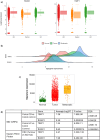Identification and Validation of Biomarkers to Predict Early Diagnosis of Inflammatory Bowel Disease and Its Progression to Colorectal Cancer
- PMID: 39325241
- PMCID: PMC12271286
- DOI: 10.1007/s10528-024-10917-z
Identification and Validation of Biomarkers to Predict Early Diagnosis of Inflammatory Bowel Disease and Its Progression to Colorectal Cancer
Abstract
Inflammatory bowel disease (IBD) has become a common global health problem as prevalence continues to rise. It is often associated with increased risk of colorectal cancer (CRC) development. Limitations in current IBD biomarker-based diagnosis hinder the accuracy of early detection of CRC progression. Therefore, in this study, we proposed the use of transcription factor (TF)-based biomarkers that can potentially detect the transition of IBD to CRC. Various bioinformatic analysis and online database validations, and RT-qPCR validations were performed to identify possible diagnostic TFs. RUNX1 was identified as a promising TF that regulates 106 IBD/CRC-related genes. The incorporation of RUNX1 in combination with currently known IBD biomarkers, FEV + NFKB1 + RELA, achieved a comparable sensitivity and specificity scores of 99% and 87%, respectively, while RUNX1 in combination with known CRC markers, CEA + TIMP1 + CA724 + CA199, achieved a sensitivity and specificity score of 97% and 99%, respectively. Furthermore, a small pilot RT-qPCR-based analysis confirmed a demarcated shift in expression profiles in CA724, CEA, RUNX1 and TIMP1 in IBD patients compared to CRC patients' tissue samples. Specifically, CA724 is noticeably elevated in IBD, while the levels of CEA, RUNX1 with TIMP1 are probable genes that may be employed in discerning IBD progression to CRC. Therefore, these preliminary results once validated in large patient cohorts could potentially have a significant impact on CRC disease stratification, resulting in a more precise prediction for treatment and treatment outcomes, especially in South African patients.
Keywords: Colorectal cancer; Diagnostic biomarkers; In silico and wet-lab validation; Inflammatory bowel disease; Predictive markers; Transcription factors.
© 2024. The Author(s).
Conflict of interest statement
Declarations. Conflict of interest: The authors declare no competing interests. Ethics Approval: Ethics approval was obtained from the human research ethics committee (Medical), University of the Witwatersrand (Clearance Number: M170391).
Figures




References
MeSH terms
Substances
Grants and funding
LinkOut - more resources
Full Text Sources
Medical
Research Materials
Miscellaneous

